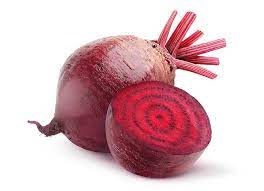 The beetroot is the taproot portion of a beet plant, usually known in North America as beets while the vegetable is referred to as beetroot in British English.
The beetroot is the taproot portion of a beet plant, usually known in North America as beets while the vegetable is referred to as beetroot in British English.
Species Beta vulgaris
It is one of several cultivated varieties of Beta vulgaris grown for their edible taproots and leaves, called beet greens.
Other cultivars of the same species include the sugar beet, the leaf vegetable known as chard or spinach beet, and mangelwurzel, which is a fodder crop.
Three subspecies are typically recognized.
Beetroot, raw
Nutritional value per 100 g (3.5 oz)
Energy
180 kJ (43 kcal)
Carbohydrates
9.56 g
Sugars
6.76 g
Dietary fiber
2.8 g
Fat
0.17 g
Protein
1.61 g
Vitamins
Vitamin A equiv.
beta-Carotene
0% 2 μg
0%20 μg
Thiamine (B1)
3% 0.031 mg
Riboflavin (B2)
3% 0.04 mg
Niacin (B3)
2% 0.334 mg
Pantothenic acid (B5)
3% 0.155 mg
Vitamin B6
5% 0.067 mg
Folate (B9)
27% 109 μg
Vitamin C
6% 4.9 mg
Minerals
Calcium
2% 16 mg
Iron
6% 0.8 mg
Magnesium
6% 23 mg
Manganese
16% 0.329 mg
Phosphorus
6% 40 mg
Potassium
7% 325 mg
Sodium
5% 78 mg
Zinc
4% 0.35 mg
Water
87.58g
Usually, the deep purple roots of beetroot are eaten boiled, roasted, or raw, and either alone or combined with any salad vegetable.
The green, leafy portion of the beetroot is also edible.
The young leaves can be added raw to salads, while the mature leaves are most commonly served boiled or steamed, in which case they have a taste and texture similar to spinach.
Beetroot can be roasted, boiled or steamed, peeled, cooked, pickled, shredded raw, and then eaten as a salad.
Beetroot soup, such as borscht, beetroot is combined with horseradish
Raw beetroot is 88% water, 10% carbohydrates, 2% protein, and less than 1% fat.
In a 100-gram (3+1⁄2-ounce) amount providing 180 kilojoules (43 kilocalories) of food energy, raw beetroot is a rich source (27% )of the of folate and a moderate daily source (16% DV) of manganese, with other nutrients having insignificant content.
A clinical trial review reported that consumption of beetroot juice modestly reduced systolic blood pressure but not diastolic blood pressure.
The red color compound betanin is not broken down in the body, and in higher concentrations, may temporarily cause urine or stools to assume a reddish color, beeturia, or hematochezia.
Generally, 55 to 65 days are needed from germination to harvest of the root.
All cultivars can be harvested earlier for use as greens.
The root colors are shades of red and dark red, with different degrees of zoning noticeable in slices.
